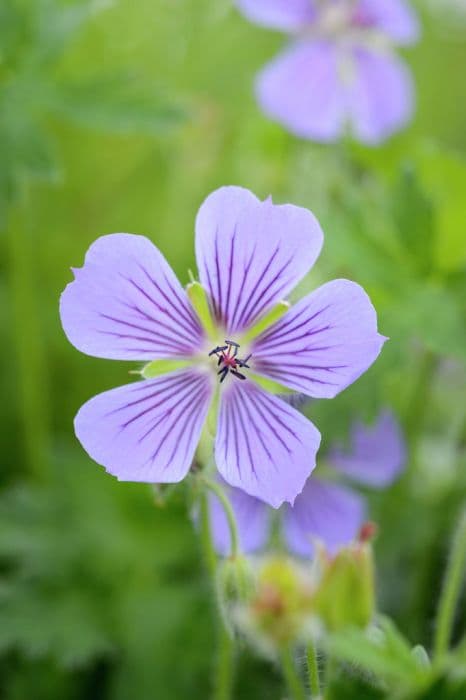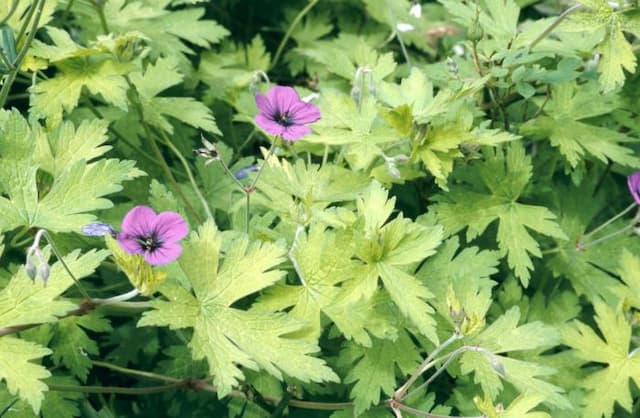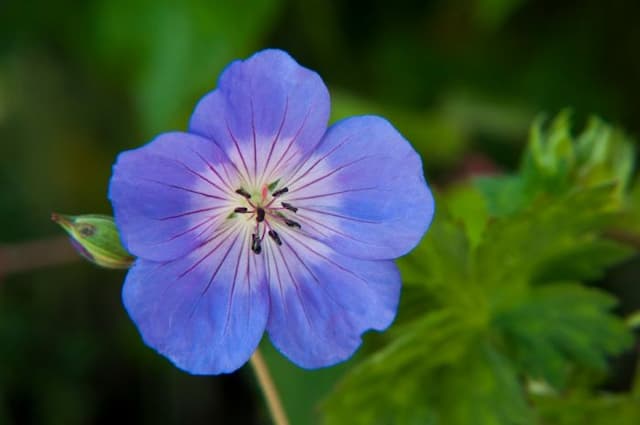Caucasian Cranesbill Geranium ibericum Cav. 'Ushguli Grijs'

ABOUT
Geranium ibericum Cav. 'Ushguli Grijs', commonly known as cranesbill, is a flowering perennial known for its vibrant and decorative appeal. This plant has a lush mound of deeply lobed, dark green foliage that can add texture to a garden. The leaves are usually rounded and may take on a slightly reddened tint in the fall, providing additional visual interest as the seasons change. The most striking feature of cranesbill is its flowers. They emerge in clusters on slender stems, rising above the foliage. Each bloom consitutes of five rounded petals, contributing to a simple yet elegant floral display. The petals are typically saturated with a bold blue-violet hue, creating a splash of cool-toned color in the garden. The floral arrangement often contains subtle veins or darker markings which can add depth and complexity to its appearance. The center of each flower has lighter shading or white coloring, and features prominent stamens which stand out against the petals, drawing in pollinators such as bees and butterflies. After the flowering period, the plant may produce distinctive beak-like seed pods from which the common name 'cranesbill' is derived. Cranesbills have a loose and spreading habit, contributing to a naturalistic or cottage garden feel. They are often used for borders, rock gardens, or as a groundcover due to their easy-going nature and ability to fill space with their attractive leaves and blooms. Their adaptive nature and resilience to different garden conditions make them a popular choice for many gardeners looking to add long-lasting color and texture to their outdoor spaces.
About this plant
 Names
NamesFamily
Geraniaceae.
Synonyms
Iberian Crane's-bill, Caucasian Cranesbill, Ushguli Grijs Geranium.
Common names
Geranium ibericum Cav.
 Toxicity
ToxicityTo humans
Geranium ibericum Cav. 'Ushguli Grijs', commonly known as cranesbill, is not typically known to be toxic to humans. The Geranium genus overall contains many species that are commonly grown in gardens and are not considered poisonous. Ingesting parts of the cranesbill plant is generally not expected to cause adverse effects or symptoms of poisoning in humans. However, as with any plant, individual allergies or sensitivities can vary, so it is always advisable to exercise caution and avoid ingesting plants unless they are known and proven to be edible.
To pets
Cranesbill, the common name for Geranium ibericum Cav. 'Ushguli Grijs', is generally considered non-toxic to pets. The Geranium genus, which includes cranesbill, is not listed by major pet poison control resources as a plant that typically causes poisoning in pets. Consuming parts of this plant should not lead to significant toxicity or symptoms of poisoning in pets. However, some animals may experience mild gastrointestinal upset if they ingest large quantities of non-food items, including non-toxic plants, due to the physical act of eating unusual matter.
 Characteristics
CharacteristicsLife cycle
Perennials
Foliage type
Deciduous
Color of leaves
Green
Flower color
Blue
Height
1-2 feet (30-60 cm)
Spread
1-2 feet (30-60 cm)
Plant type
Herb
Hardiness zones
5
Native area
Caucasus
Benefits
 General Benefits
General Benefits- Aesthetic Appeal: Geranium ibericum adds vibrant color and texture to gardens with its vivid blue-violet flowers and attractive foliage.
- Low Maintenance: It is a hardy perennial that requires minimal upkeep once established, making it ideal for gardeners of all skill levels.
- Drought Tolerance: Once established, the plant has good tolerance to drought, reducing the need for frequent watering.
- Pollinator Attraction: The blooms attract bees, butterflies, and other pollinators, helping to support local ecosystems.
- Ground Cover: It can act as an effective ground cover, suppressing weeds and reducing soil erosion with its dense foliage.
- Seasonal Interest: Geranium ibericum provides seasonal interest with its extended flowering period from late spring to early summer.
 Medical Properties
Medical Properties- Antibacterial: Geranium ibericum has shown potential in fighting bacteria, which could make it useful in treating infections.
- Anti-inflammatory: The plant may help reduce inflammation, which is beneficial for a variety of inflammatory conditions.
- Antioxidant: Contains compounds that can neutralize harmful free radicals, potentially preventing cell damage.
- Astringent: Can be used to tone the skin and tissues, helping to reduce secretions and control bleeding.
- Hemostatic: Might be useful in stopping bleeding, both internally and externally.
- Diuretic: Promotes the production of urine, which can help in detoxification and the treatment of urinary tract conditions.
 Air-purifying Qualities
Air-purifying QualitiesThis plant is not specifically known for air purifying qualities.
 Other Uses
Other Uses- The crushed leaves of Geranium can be used to create a natural dye for fabric, offering hues ranging from greens to browns depending on the mordant used.
- Geranium can be planted as part of a companion planting system to deter pests from neighboring vegetable crops due to its strong scent.
- Because of its attractive flowers, Geranium is often used in cottage gardens to provide a traditional, rustic look.
- Geranium can be used in potpourri mixes for its aromatic foliage, contributing a fresh, pleasant scent to the blend.
- The plant is also used in floral arrangements to provide bulk and filler with its foliage and long-lasting flowers.
- Geranium leaves can be laid among linens and clothes to impart a fresh fragrance and possibly deter moths.
- When used in landscaping, Geranium can function as a ground cover, helping to prevent soil erosion on slopes and banks.
- The essential oils extracted from Geranium may be utilized in aromatherapy for creating a calming and uplifting atmosphere.
- In permaculture, Geraniums can be employed as part of a guild to attract beneficial insects that help maintain the health of the ecosystem.
- The petals of Geranium can be pressed and incorporated into homemade paper for decorative purposes, adding texture and color.
Interesting Facts
 Feng Shui
Feng ShuiThe Geranium is not used in Feng Shui practice.
 Zodiac Sign Compitability
Zodiac Sign CompitabilityThe Geranium is not used in astrology practice.
 Plant Symbolism
Plant Symbolism- Unity: Geraniums often symbolize unity and togetherness, representing the harmony of all elements in a circle.
- Friendship: Giving a geranium is a traditional sign of friendship, as the plant is seen as a symbol of positive bonds between friends.
- Health and Healing: Historically, geraniums have been associated with health and used in healing practices, thus they symbolize wellbeing.
- Fertility and Prosperity: Their lush growth can indicate fertility and, by extension, prosperity, reflecting a hope for abundance.
- Protection: Some cultures plant geraniums to ward off evil spirits, evoking the plant’s protective symbolism.
 Water
WaterFor the Hardy Geranium, which is the common name for Geranium ibericum, it is important to maintain consistent moisture without overwatering. During the growing season, it typically requires watering once a week, but this can vary depending on the climate and soil type. Make sure the top inch of soil is dry before watering again. When watering, thoroughly soak the soil to encourage deep root growth, using about one gallon of water per plant. During hot spells or drought, increase watering frequency to prevent stress.
 Light
LightHardy Geraniums thrive in full sun to partial shade conditions. They perform best when they receive at least six hours of sunlight per day, but they can also tolerate some shade, especially in hot climates where they benefit from protection from the intense afternoon sun. The ideal spot is one where morning sunlight is abundant and there is some dappled shade in the afternoon.
 Temperature
TemperatureHardy Geraniums are fairly tolerant of a range of temperatures and can survive in minimum temperatures as low as 20 degrees Fahrenheit, which is their general cold hardiness threshold. However, the ideal growing temperatures are between 60 and 75 degrees Fahrenheit for optimal growth. They are not suited to extreme heat and can suffer if temperatures consistently exceed 85 degrees Fahrenheit.
 Pruning
PruningHardy Geraniums benefit from pruning to encourage bushier growth and more prolific blooming. Prune or deadhead spent blooms regularly throughout the blooming season to promote continuous flowering. In the spring or after the first flush of flowers, cut back the plant by one-third to refresh the foliage and encourage a second bloom. Pruning in late fall or early winter can tidy up the plant and prepare it for the next growing season.
 Cleaning
CleaningAs needed
 Soil
SoilThe Caucasian crane's bill (Geranium ibericum) thrives in fertile, well-draining soil with a pH range from neutral to slightly acidic. A good mix for this plant would be equal parts garden soil, peat, and sharp sand or perlite. Amendments like compost or well-rotted manure can also be beneficial to enhance soil fertility and structure.
 Repotting
RepottingCaucasian crane's bill should be repotted every 2 to 3 years to refresh the soil and to accommodate the growth of the plant. Spring is the ideal time for repotting, just before the onset of the growing season.
 Humidity & Misting
Humidity & MistingCaucasian crane's bill prefers a moderate humidity level and is quite adaptable to average home humidity levels. Avoiding conditions that are too dry or too humid is best for the health of the plant.
 Suitable locations
Suitable locationsIndoor
Place in bright, indirect light.
Outdoor
Needs full sun to partial shade.
Hardiness zone
4-8 USDA
 Life cycle
Life cycleGeranium ibericum, commonly known as the Caucasian Crane's-bill, begins its life as a seed that germinates in the spring when soil temperatures and moisture levels are adequate. The seedling stage is marked by the emergence of the cotyledons (seed leaves) followed by the true leaves as it establishes a root system and begins photosynthesis. The vegetative stage is characterized by rapid growth of foliage as the plant matures and develops a robust stem structure, which allows for the development of more leaves and the necessary infrastructure to support future flowers. Flowering occurs in late spring to early summer, with the plant producing distinctive violet-blue flowers that attract pollinators for sexual reproduction. Following pollination, the plant forms seed capsules that, when mature, dehisce to release the seeds, completing its reproductive cycle. The plant then enters a senescent phase, either preparing for dormancy in colder climates or dying back if it is an annual, with seeds remaining to restart the life cycle in the following growing season.
 Propogation
PropogationPropogation time
Spring-Early Summer
Propogation: Cranesbill, also known by its botanical name Geranium ibericum Cav. 'Ushguli Grijs', is often propagated through division. The most popular method for this perennial plant involves dividing the rootball, ideally during early spring or fall when the plant is not in active bloom. Carefully dig up the plant, ensuring you get a good amount of the root system, and use a sharp knife or spade to cut the root mass into several pieces. Each piece should have at least one shoot and a portion of the root system. Replant the divisions promptly, maintaining the same soil depth they were at originally, and water thoroughly to help the roots establish. Typically, a spacing of about 12 to 18 inches (approximately 30 to 45 centimeters) between the new plants is recommended to ensure enough room for growth.









